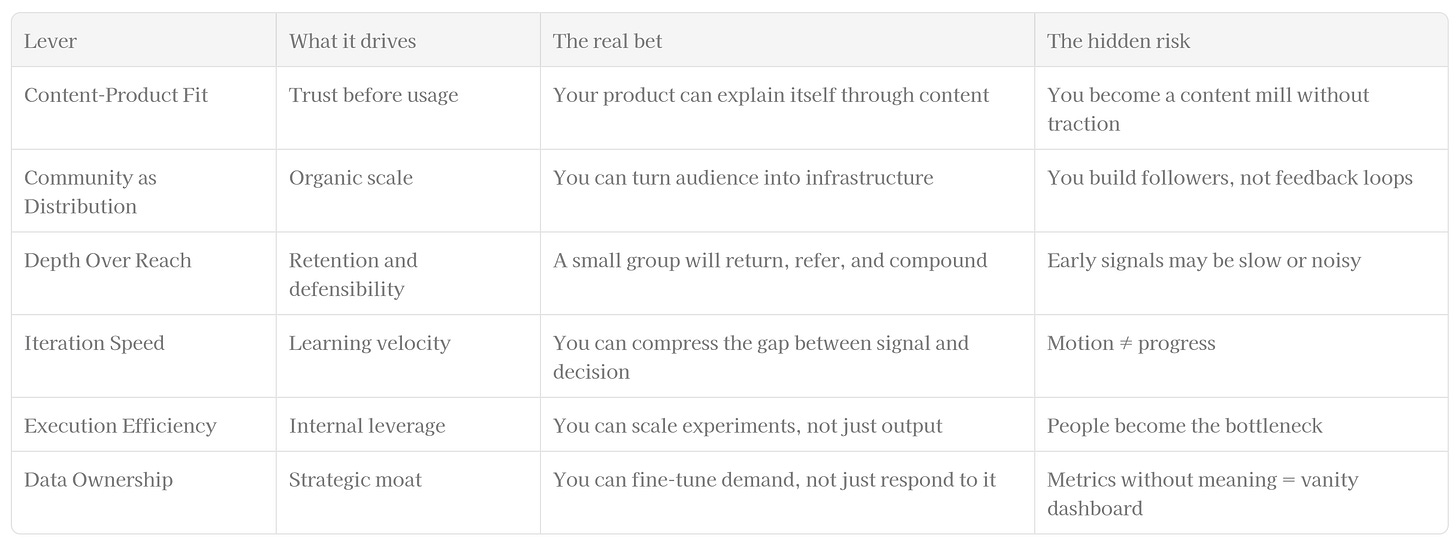If Everyone’s Using the Same Model, What Are We Even Building?
Speed, Ownership, and the Cost of Building in AI Times
Hi I’m Angela 🧸
A product growth marketer who exists in the space between caffeine highs and retention lows.
Building Products in the AI Era:
The Deep Logic of Speed, Content, and Data Ownership
In a world shaped by AI-native platforms and infinite noise, the way you build is as strategic as what you build. In 2025, traditional feature stacking and superficial differentiation won’t cut it any
Building a product today means moving forward without a clear map. Users don’t wait around for perfect features. Markets shift faster than roadmaps. Teams face signals that are often incomplete or conflicting.
Who should read this
Anyone struggling to build products while facing unclear user needs and shifting market demands.
Why read this
If you want to survive and win in today’s AI era.
Key takeaways
Product development happens amid constant uncertainty with incomplete user signals.
Traditional roadmaps fail in fast-changing markets.
Content distribution and deep community engagement create essential feedback loops and build real user trust.
Success today depends on teams maintaining alignment and an adaptable working rhythm amid the rapid iteration cycles of the AI era.
How AI-native platforms are rewriting product strategy
AI-native platforms have become the gravitational center of product innovation
Today, every startup fights with the same tools: GPT, Claude, Midjourney. What used to be your “edge” is now the default.
What changed? AI-native platforms created a new gravity field. You're not building a product in isolation anymore, you're orbiting foundation models that control speed, quality, and distribution. Every startup, like it or not, has been pulled into this orbit.
This strategic dependency forces a new question:
"If the model updates tomorrow, will my product feel outdated?"
Startup development pace is no longer fully autonomous; it depends heavily on the release schedules and capability limits of model APIs (e.g., context length, embedding quality, cost efficiency)
Platform asymmetries in data access, model iteration speed, and built-in user distribution (such as ChatGPT Plugins or Gemini Apps) concentrate innovation opportunities unevenly
Building different features won’t set you apart anymore. What matters is your position in the AI supply chain.
We’re operating inside the “gravity well” of giant AI foundation models that own the core capabilities.
They’ve become gravitational centers in the tech ecosystem.
Innovation today involves more than starting from zero. Success depends on moving in step with these foundational models while maintaining independence from their full control.
To avoid being swallowed whole, products must strategically bet on speed, content, community, iteration, execution, and data control.
Most teams focus on features.
Feature differentiation no longer works; users care about platform fit
Early users don’t care about clever features. They care about whether you work with the tools they already trust.
As user behavior centers around AI platforms, single-point feature innovation struggles to shift user habits
So-called “new features” can actually become onboarding friction, especially in enterprise contexts where workflow consistency is critical
Case studies of major products like Notion AI and Figma AI prioritizing platform integration over standalone feature differentiation
But the best ones are optimizing six invisible levers, levers that separate products that survive from those that just ship.
Here’s the framework.
(And what you’re really betting on when you prioritize them.)
1. Content-Product Fit: When Content Becomes the Prototype of Product Perception
Historically, content was an afterthought, a marketing add-on designed to educate or persuade. Today, content itself is the product experience that users engage with before they even open the app. It no longer just explains what the product does; it embodies the product’s value proposition.
Take Notion, for example: their help docs, templates, and community tutorials don’t just educate, they demonstrate what the product can do and how it fits individual workflows. Users mentally simulate the experience through content, reducing friction and skepticism.
The organizational implication is clear:
Content must be embedded within product strategy, not siloed in marketing.
If not, content becomes noise.
This shift has two major consequences:
Users mentally simulate the product through content, lowering friction and setting expectations before any hands-on interaction.
Content becomes an integral part of the product’s value delivery. If you miss this, content risks becoming nothing more than noise.
This changes organizational priorities profoundly. Content teams can no longer exist in isolation within marketing, they need to collaborate closely with product and user research teams. KPIs shift from vanity metrics like page views or likes to metrics tied directly to user growth and retention.
More importantly, the line between product and market blurs.
When content and product are tightly integrated, acquisition costs drop, onboarding smooths out, and product diffusion accelerates naturally.
Beyond the Surface
The real challenge is operationalizing this.
How do you shift KPIs, integrate content and product teams, and align incentives to reflect content as product?
This requires cultural shifts and new cross-functional workflows few teams master. The stakes? Without this, scaling content-product fit at pace becomes impossible.
2. Community as Distribution & Feedback Loop: From Audience to Ecosystem
AI-native products must build distribution into their core or risk becoming mere feature demos
Community isn’t a broadcast channel, it’s the nervous system of your product’s ecosystem. When users organize around shared goals and feel real participation, they cease to be passive consumers. Instead, they become co-creators, feedback loops, and grassroots innovators.
Discord servers like Figma’s are not mere fan clubs; they’re active labs for user feedback, plugin ideas, and design collaboration. This ecosystem drives product decisions, testing, and evangelism simultaneously.
Trends in API development from platforms like Substack, X, and Notion
Where successful startups often integrate with existing platform distribution channels (plugins, extensions, app embedding)
In the absence of clear AI product search and discovery mechanisms, distribution is not optional but essential
Examples like Midjourney’s Discord community, ChatGPT Plugins, and Gemini Cards show that embedding within a platform’s ecosystem is the primary distribution channel
The true power lies in two-way interaction. Communities provide rapid hypothesis validation and help shape product direction. Without this dynamic, communities risk becoming echo chambers, vibrant on the surface, but ineffective at driving meaningful growth or product improvement.
Building this feedback mechanism requires intentional design, not just posting updates, but structuring channels where conversations influence product decisions and spark collaborative problem-solving.
3. Depth Over Reach: Sustainable Growth Lives in Repeat Engagement
Chasing viral spikes and rapid user acquisition is tempting but often hollow. Massive user counts mean little if most abandon the product after first use. Real defensibility comes from depth, users who return, engage deeply, and embed the product into their routines.
This shift requires patience and discipline. Early signals of depth can be subtle and slow to emerge, making it easy to mistake surface-level stagnation for failure.
Understanding and trusting these nuanced metrics is critical. It’s about building compounding value over time, turning casual visitors into loyal users, the kind who don’t just consume but advocate.
TikTok’s meteoric growth is instructive here. It’s not just viral clips, but the infinite scroll and personalization loop that keeps users coming back hour after hour. Contrast that with apps chasing explosive downloads but failing retention, growth is hollow without depth.
The lesson: early-stage signals of deep engagement are subtle. Misreading them leads to premature pivots or missed opportunities.
Figure 2: Strategic Priority Matrix4. Iteration Speed: Learning Velocity, Not Just Feature Velocity
Speed is the mantra of modern product teams, but the distinction between moving fast and moving fast with insight is everything. The value of iteration comes from rapid, data-informed learning cycles that drive strategic decisions, not just throwing features at the wall to see what sticks.
High-velocity iteration means building systems to capture user behavior, analyze feedback, and pivot efficiently. Without this, fast releases become noise, creating technical debt and team fatigue without meaningful progress.
It’s the difference between running fast in the wrong direction and running fast on a path that’s constantly recalibrated with fresh insight.
Consider how Stripe releases dozens of small API improvements monthly, backed by rigorous data and developer feedback. Speed is not about shipping fast for its own sake, but learning fast, turning usage signals into strategic adjustments. Teams that confuse activity with insight accumulate technical debt.
5. Execution Efficiency: Systems Over Heroes
Execution isn’t about individual grit or overtime hours. It’s about building repeatable, scalable systems that reduce friction and ambiguity within the team.
High execution efficiency means clear roles, well-defined processes, and reliable communication flows, enabling teams to solve complex problems collectively without bottlenecks.
When execution depends on heroic efforts by individuals, the organization risks burnout and inconsistent delivery. Over time, this creates invisible debt that hampers growth.
Amazon’s legendary operational rigor exemplifies this principle. It’s not the overtime of a few key players but a scalable process-driven culture that sustains growth. Startups relying on “all hands on deck” heroics face burnout and unpredictable delivery. Execution efficiency is the unseen architecture behind consistent expansion.
6. Data Ownership: From Passive Observation to Active Influence
Owning your data isn’t just about having access to metrics, it’s about controlling the input layer that shapes your product and business model.
In a world where major AI platforms dictate the capabilities and parameters of foundational models, lack of data sovereignty means ceding strategic control. Your product becomes reactive, bound by external constraints and prone to commoditization.
True defensibility arises when you own your data streams, enabling you to influence or even fine-tune the underlying models powering your product. This shifts you from being a downstream consumer to an upstream shaper of your market.
OpenAI’s partnership with Microsoft shows the power of data ownership. By controlling usage data and fine-tuning GPT models, they influence model behavior, securing a moat beyond surface UX. Products that treat AI as a black box are at mercy of platform changes and commoditization.
Figure 3: Lever Interaction DiagramConclusion
These six pillars aren’t mere operational checkboxes.
They represent strategic bets on where your product lands in a landscape increasingly dominated by AI infrastructure and platform power.
They differentiate between products that merely float on the surface and those that build deep, defensible moats.
Understanding these layers, from content shaping perception to owning data flows, is critical to escaping commoditization and unlocking sustainable growth.
Still alive in market, and your self-doubt?
Cool. Most great products start right there.
If you survived this dispatch without mental breaks, Anchor sends caffeine.
Recommend this colony log to your fellow survivors.










Fascinating. It's really a whole new world out there when it comes to product development. Also, I can see this being applicable not just to startups but also for solopreneurs and content creators.
This is music to my ears 🎶, so good:
"Chasing viral spikes and rapid user acquisition is tempting but often hollow. Massive user counts mean little if most abandon the product after first use. Real defensibility comes from depth, users who return, engage deeply, and embed the product into their routines."